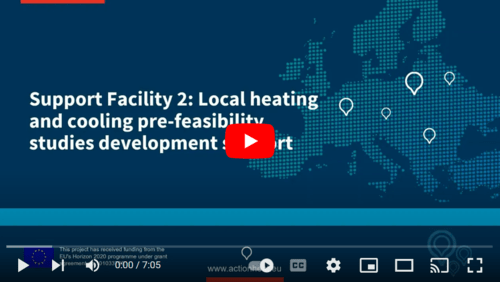Support Modules Project Feasibility
The Act!onHeat assistance for heating and cooling planning was structured in different modules according to the Act!onHeat workflow. The modules presented on this page were for the 'Support Facility for Project Feasibility.' A separate set of support modules is available for 'H&C transition strategy development.
The support focused on the development of techno-economic pre-feasibility studies for localised heating or cooling projects.
Projects that received support comprised a range of different approaches to heat decarbonisation, such as individual building solutions and the development / extension of heat networks at various scales. The provision of support was based primarily on the use of the THERMOS tool to identify, develop and characterise a range of scenarios to achieve the required techno-economically optimal heat decarbonisation objectives.
Example activities offered under this support facility are in the videos and described below across a range of typical project feasibility work areas.
Work areas and possible support activities
| Familiarisation with THERMOS |
|---|
| Training sessions on THERMOS tailored to suit user requirements. |
| Run through of case studies to demonstrate the real-world applications of THERMOS. |
| Data preparation for heat-ing and cooling demand estimation |
|---|
| Assistance in specifying and identifying LiDAR data for a defined area to obtain building heights. |
| Assistance in compiling local GIS buildings and roads data to supplement or replace OpenStreetMap data (including future development). |
| Guidance on formatting locally-sourced energy demand data to supplement THERMOS model. |
| Estimation of building heating and cooling demands for a defined area using THERMOS |
|---|
| Basic estimation of peak and annual demands [using Open-StreetMap polygon data]. |
| Advanced estimation of peak and annual demands [using Open-StreetMap polygon data and building height], possibly supplemented with locally-sourced demand data. |
| Heat mapping to produce visual representation of spatial heat demand density. |
| Development of heat network scenarios for optimisation using THERMOS |
|---|
| Defining buildings and roads/pathways to be included in analysis, including incorporation of future developments |
| Specification of heat supply options and their location. |
| Guidance on economic objectives and technical parameters and variables to be used in network optimisation model. |
| Development of network scenarios that incorporate a phased roll-out. |
| Optimisation of heat network scenarios using THERMOS |
|---|
| Support with running optimisations. |
| Diagnostics and troubleshooting of problem scenarios. |
| Support on adjusting scenarios and iteration of optimisation runs. |
| Optimisation of energy supply plant using THERMOS |
|---|
| Guidance on specifying energy demand profiles. |
| Guidance on specifying supply economic objectives and technologies. |
| Presentation and analysis of results |
|---|
| Support with collation and interpretation of output data. |
| Comparison between optimised network solutions. |
| Comparison between optimised heat supply solutions. |
| Presentation of KPIs and sensitivity analysis. |
| Assessment of financial and governance options (for a selected number of projects only) |
|---|
| Assessment of public, private, and mixed financing options at regional, national, and EU level, tailored to the explicit needs of each municipality. |
| Guidance on accessing various funding sources, complemented by case studies of successful applications. |
| Economic feasibility analysis of local heat projects, including high-level profitability calculations. |
Subscribe to our Newsletter

This project has received funding from the European Union’s Horizon 2020 research and innovation program under grant agreement No 101033706. The sole responsibility for the content of this website lies with the Act!onHeat project and does not necessarily reflect the opinion of the European Union.








